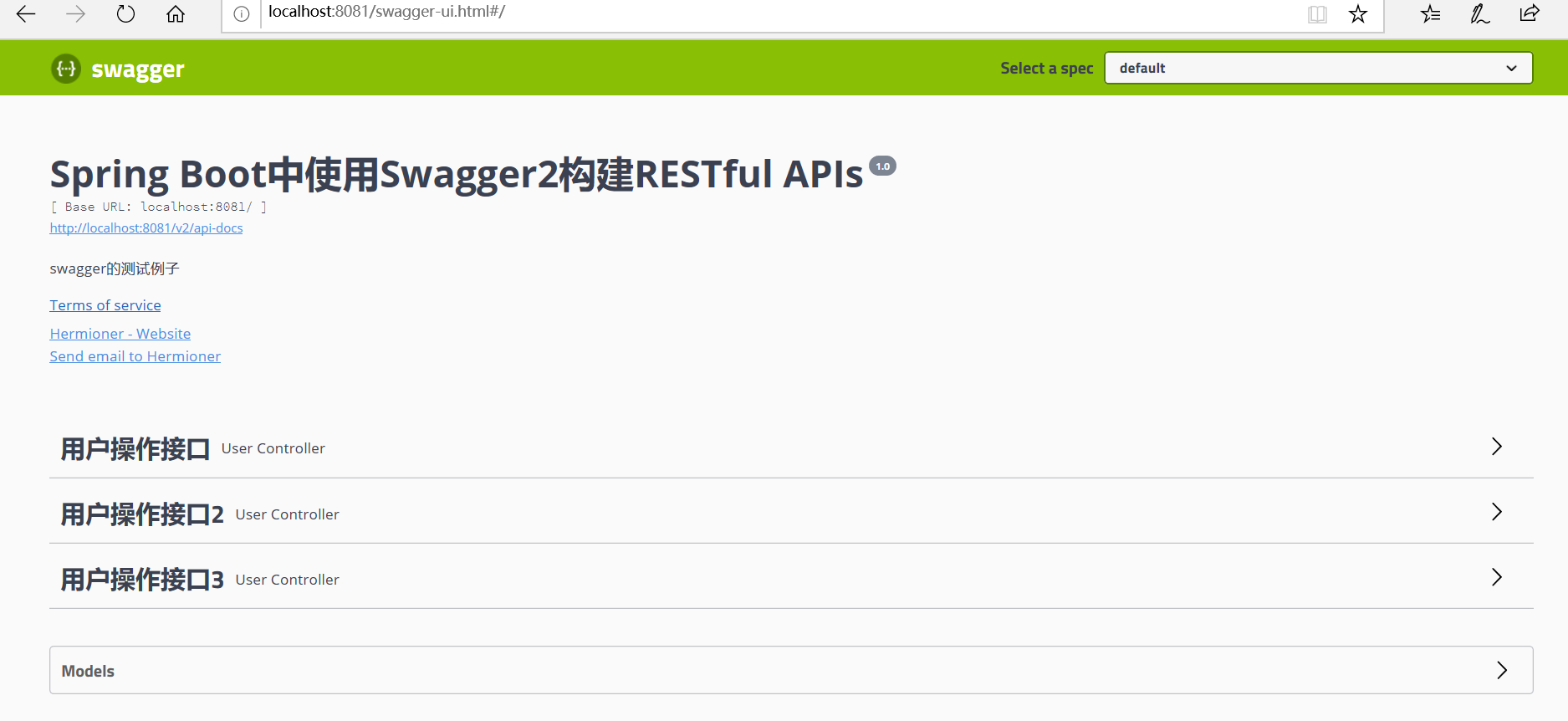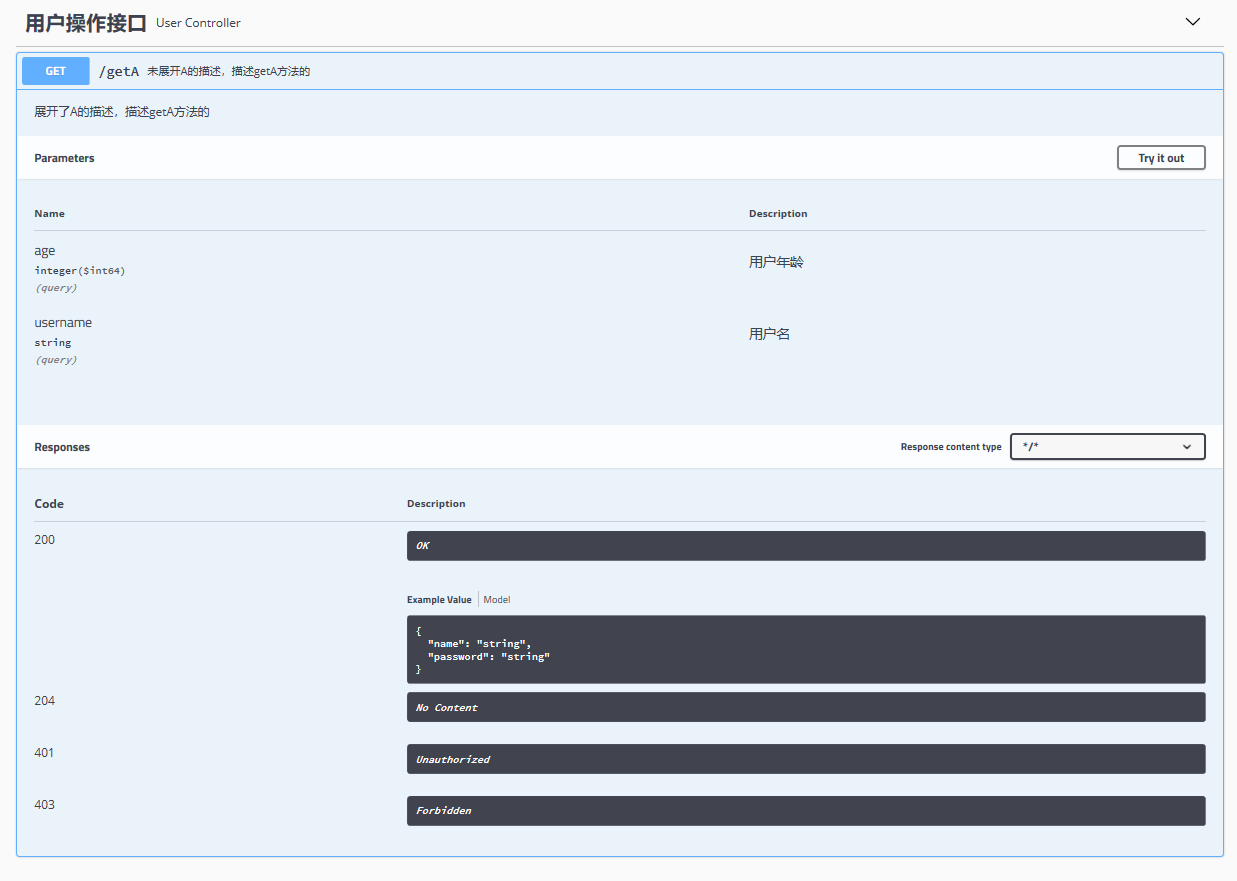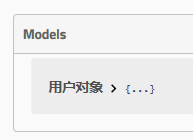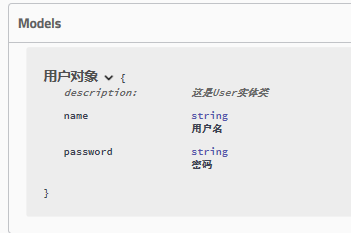swagger
一.Swagger简介
我们在项目开发中,经常会写接口文档。但是随着代码的不断更新,我们需要花费大量的精力去修改接口文档。即使是修改了接口文档,还是会存在更新不及时,更新不匹配等问题存在。为了统一接口规范,Swagger就顺势而生啦。它能提供一个统一的接口文档规范。但是虽然有了这个统一的接口规范(Swager)了,开发来编写这些json或者yml的描述文件还是比较麻烦,甚至还会忘记去更新描述文件件,只是更新自己开发的代码。因此,Spring就迅速的将Swagger规范纳入自身的标准,建立了Srping-swagger项目,后面改成了现在的Springfox。通过在项目引入Springfox相关依赖,就可以通过扫描代码生成描述文件,从而根据这个描述文件生成我们的接口文档了。这样就既方便有匹配的拥有接口文档了。
一般在pom.xml中引入如下两个依赖就好了。如果出现报错,找不到加载类,还需要引入swagger-models(因为可能会版本不兼容,导致类加载失败)。

1 <dependency> 2 <groupId>io.springfox</groupId> 3 <artifactId>springfox-swagger2</artifactId> 4 <version>2.9.2</version> 5 </dependency> 6 7 <dependency> 8 <groupId>io.springfox</groupId> 9 <artifactId>springfox-swagger-ui</artifactId> 10 <version>2.9.2</version> 11 </dependency>
二.Swagger常用注解介绍
这里总结一下我在项目常用到的注解及其常用参数:
2.1 @API 用在Controller类上
| value | 在swagger-ui上不显示。配置了tags后这个value不需要再配置了 |
| description或者tags |
在swagger-ui上显示,可以当做备注使用,描述这个Controller的信息 在新版本的swagger2中description已被淘汰,可以用tags代替,但是不更改也不会影响使用。 但是tags如果有多个值,会生成多个list |
2.2 @ApiOperation 用在方法上,表示一个http请求
| value | 接口说明,是接口文档没有展开时的描述信息,比较简短 |
| httpMethod | 接口请求方式,指定http模式,参数有"POST"、"DELETE"、"GET"、"HEAD"等 |
| notes | 接口发布说明,是接口文档展开时的描述信息,可以写较value更加详细 |
2.3 @ApiParam 用于方法参数
| value | 参数的具体描述 |
| name | 参数名称 |
| required | 是否是必选参数,如果是true,就代表必选参数 |
2.4 @ApiModel 用于返回对象类,描述返回对象的意义
| value | 对象名 |
| description | 用于对对象的描述 |
2.5 @ApiModelProperty 用于属性的描述
| value | 字段说明 |
| name | 运行覆盖属性的名称。重写属性名称 |
| required | 是否为必传参数 |
2.6 @ApiImplicitParam()和@ApiImplicitParams()
@ApiImplicitParam() 用于方法,表示单独的请求参数
@ApiImplicitParams() 用于方法,包含多个 @ApiImplicitParam
| name | 参数名 |
| value | 参数说明 |
| paramType | 参数类型 |
| example | 举例说明 |
三. 具体实例
本例子将会用到上面介绍的所有注解,项目采用springboot+maven搭建而成,具体做法不介绍了。
3.1 准备一个springboot项目,引入相关swagger依赖,项目结构如下,主要关注红色部分:

依赖配置:

1 <?xml version="1.0" encoding="UTF-8"?> 2 <project xmlns="http://maven.apache.org/POM/4.0.0" xmlns:xsi="http://www.w3.org/2001/XMLSchema-instance" 3 xsi:schemaLocation="http://maven.apache.org/POM/4.0.0 https://maven.apache.org/xsd/maven-4.0.0.xsd"> 4 <modelVersion>4.0.0</modelVersion> 5 <parent> 6 <groupId>org.springframework.boot</groupId> 7 <artifactId>spring-boot-starter-parent</artifactId> 8 <version>2.2.5.RELEASE</version> 9 <relativePath/> <!-- lookup parent from repository --> 10 </parent> 11 <groupId>com.example</groupId> 12 <artifactId>LunTan</artifactId> 13 <version>0.0.1-SNAPSHOT</version> 14 <name>LunTan</name> 15 <description>Demo project for Spring Boot</description> 16 17 <properties> 18 <java.version>1.8</java.version> 19 <maven-jar-plugin.version>3.1.1</maven-jar-plugin.version> 20 </properties> 21 22 <dependencies> 23 <dependency> 24 <groupId>org.springframework.boot</groupId> 25 <artifactId>spring-boot-starter-web</artifactId> 26 </dependency> 27 28 <dependency> 29 <groupId>io.swagger</groupId> 30 <artifactId>swagger-core</artifactId> 31 <version>1.5.21</version> 32 </dependency> 33 34 <!-- https://mvnrepository.com/artifact/io.swagger/swagger-models --> 35 <dependency> 36 <groupId>io.swagger</groupId> 37 <artifactId>swagger-models</artifactId> 38 <version>1.5.21</version> 39 </dependency> 40 41 42 <dependency> 43 <groupId>org.springframework.boot</groupId> 44 <artifactId>spring-boot-starter-websocket</artifactId> 45 </dependency> 46 <!-- https://mvnrepository.com/artifact/javax.servlet/javax.servlet-api --> 47 <dependency> 48 <groupId>javax.servlet</groupId> 49 <artifactId>javax.servlet-api</artifactId> 50 <scope>provided</scope> 51 </dependency> 52 <!-- https://mvnrepository.com/artifact/io.springfox/springfox-swagger2 --> 53 <dependency> 54 <groupId>io.springfox</groupId> 55 <artifactId>springfox-swagger2</artifactId> 56 <version>2.9.2</version> 57 </dependency> 58 59 60 <dependency> 61 <groupId>org.springframework.boot</groupId> 62 <artifactId>spring-boot-starter-test</artifactId> 63 <scope>test</scope> 64 <exclusions> 65 <exclusion> 66 <groupId>org.junit.vintage</groupId> 67 <artifactId>junit-vintage-engine</artifactId> 68 </exclusion> 69 </exclusions> 70 </dependency> 71 <!-- https://mvnrepository.com/artifact/io.springfox/springfox-swagger-ui --> 72 <dependency> 73 <groupId>io.springfox</groupId> 74 <artifactId>springfox-swagger-ui</artifactId> 75 <version>2.9.2</version> 76 </dependency> 77 78 </dependencies> 79 80 <build> 81 <plugins> 82 <plugin> 83 <groupId>org.springframework.boot</groupId> 84 <artifactId>spring-boot-maven-plugin</artifactId> 85 </plugin> 86 </plugins> 87 </build> 88 89 </project>
3.2 各个类的具体实现:
(1)swagger配置类:用来启动swagger

1 package com.example.demo.swagger; 2 3 import org.springframework.context.annotation.Bean; 4 import org.springframework.context.annotation.Configuration; 5 6 import springfox.documentation.builders.ApiInfoBuilder; 7 import springfox.documentation.builders.PathSelectors; 8 import springfox.documentation.builders.RequestHandlerSelectors; 9 import springfox.documentation.service.ApiInfo; 10 import springfox.documentation.service.Contact; 11 import springfox.documentation.spi.DocumentationType; 12 import springfox.documentation.spring.web.plugins.Docket; 13 import springfox.documentation.swagger2.annotations.EnableSwagger2; 14 /** 15 * Swagger的配置类 16 * 1.EnableSwagger是开启Swagger的意思,Configuration是声明当前类是一个配置类 17 * 2.createRestApi方法不需要更改,主要用于swagger的初始化设置 18 * 19 * 20 */ 21 @Configuration 22 @EnableSwagger2 23 public class SwaggerConfig { 24 25 @Bean 26 public Docket createRestApi() { 27 return new Docket(DocumentationType.SWAGGER_2) 28 .apiInfo(apiInfo()) 29 .select() 30 .apis(RequestHandlerSelectors.basePackage("com.example.demo.controller")) 31 .paths(PathSelectors.any()) 32 .build(); 33 } 34 35 private ApiInfo apiInfo() { 36 return new ApiInfoBuilder() 37 .title("Spring Boot中使用Swagger2构建RESTful APIs") 38 .description("swagger的测试例子") 39 .termsOfServiceUrl("https://www.cnblogs.com/Hermioner/")//(不可见,条款地址,公司内部使用的话不需要配置) 40 .contact(new Contact("Hermioner", "https://www.cnblogs.com/Hermioner/", "没有邮箱@admin.com"))//作者信息 41 .version("1.0") 42 .build(); 43 } 44 45 }
就当成固定的写法就行,可以选择性的要一些设置。
* 创建API应用
* apiInfo() 增加API相关信息
* 通过select()函数返回一个ApiSelectorBuilder实例,用来控制哪些接口暴露给Swagger来展现,
* basePackage:扫描该包下面的API注解
(2)controller类:UserController

1 package com.example.demo.controller; 2 3 import org.springframework.web.bind.annotation.RequestMapping; 4 import org.springframework.web.bind.annotation.ResponseBody; 5 import org.springframework.web.bind.annotation.RestController; 6 7 import com.example.demo.bean.User; 8 9 import io.swagger.annotations.Api; 10 import io.swagger.annotations.ApiImplicitParam; 11 import io.swagger.annotations.ApiImplicitParams; 12 import io.swagger.annotations.ApiOperation; 13 import io.swagger.annotations.ApiParam; 14 15 16 @RestController 17 @Api(value="用户controller,我不得显示出来哟",tags= {"用户操作接口","用户操作接口2","用户操作接口3"}) 18 public class UserController { 19 20 @RequestMapping("/getA") 21 @ResponseBody 22 @ApiOperation(value="未展开A的描述,描述getA方法的",notes="展开了A的描述,描述getA方法的", httpMethod = "GET") 23 @ApiImplicitParams({ 24 @ApiImplicitParam(name="username",value="用户名",dataType="string",paramType="query",example="张三"), 25 @ApiImplicitParam(name="age",value="用户年龄",dataType="long",paramType="query") 26 }) 27 public User getA(@ApiParam(value = "用户名", name="username",required = true)String name){ 28 return new User(); 29 } 30 }
(3)实体类:User

1 package com.example.demo.bean; 2 3 import io.swagger.annotations.ApiModel; 4 import io.swagger.annotations.ApiModelProperty; 5 6 @ApiModel(value="用户对象",description="这是User实体类") 7 public class User { 8 @ApiModelProperty(value="用户名") 9 private String name; 10 @ApiModelProperty(value="密码") 11 private String password; 12 public String getName() { 13 return name; 14 } 15 16 public String getPassword() { 17 return password; 18 } 19 20 public void setPassword(String password) { 21 this.password = password; 22 } 23 24 public void setName(String name) { 25 this.name = name; 26 } 27 }
3.3 运行结果:
(1)直接点开链接就可以查看在线API文档(默认地址: 项目实际地址/swagger-ui/html)

(2)点击“用户操作接口”:

(3)点击Get这一行:

点击右上角的try it out还可以模拟测试:

(4)点击models

展开它:






